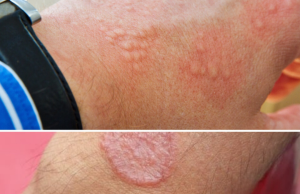At first glance, it may seem like nothing more than a fleeting skin quirk—a delicate, lace-like pattern of purple and blue spreading across the arms, legs, or torso. But this subtle discoloration, known as livedo reticularis, can be far more than just a cosmetic oddity. While often harmless, it can also serve as an early warning sign of underlying health issues lurking beneath the surface.
Understanding Livedo Reticularis
Livedo reticularis is characterized by a net-like (reticulated) mottling of the skin in reddish-purple hues. It occurs when blood flow through the small vessels under the skin becomes irregular—pooling in some areas and slowing in others—leading to reduced oxygen delivery and visible discoloration.
The pattern typically intensifies in cold conditions and may fade as the skin warms, which is why many people brush it off as a temporary circulation response. Yet, when persistent or accompanied by other symptoms, it can point to something more serious.
Two Faces of the Same Condition
Not all cases are alike. Livedo reticularis falls into two main categories:
1. Primary (Physiological) Livedo Reticularis
- Harmless and common, especially in children, young adults, and those with fair skin.
- Triggered primarily by exposure to cold temperatures.
- Fades naturally once the body warms up.
- Requires no medical treatment.
2. Secondary (Pathological) Livedo Reticularis
- Persists regardless of temperature changes.
- May signal serious underlying conditions, including:
- Vascular diseases
- Autoimmune disorders
- Blood clotting abnormalities
- Always warrants medical evaluation and possible long-term management.
What Could Be Causing It?
The causes of livedo reticularis span a wide spectrum—from benign triggers to life-altering illnesses:
- Cold exposure: The most frequent and usually innocent cause.
- Vascular conditions: Such as vasculitis or peripheral artery disease that impair normal blood flow.
- Autoimmune diseases: Including lupus, rheumatoid arthritis, and antiphospholipid syndrome—often presenting with skin manifestations.
- Blood clotting disorders: Like thrombophilia, where abnormal clotting disrupts circulation.
- Medication side effects: Certain drugs used for Parkinson’s, high blood pressure, or psychiatric conditions have been linked to livedo-like patterns.
- Rare systemic diseases: Such as Sneddon’s syndrome (associated with strokes), polyarteritis nodosa, or cholesterol embolization syndrome.
In these rarer cases, livedo isn’t just a symptom—it’s a clue.
Recognizing the Warning Signs
While the hallmark is the distinctive webbed skin pattern, certain accompanying symptoms should raise concern:
- Persistent coldness, numbness, or tingling in affected limbs
- Pain, cramping, or heaviness—especially in the legs
- Development of skin ulcers or sores
- Neurological signs like headaches, vision disturbances, or stroke-like episodes
If the mottling disappears with warmth and causes no discomfort, it’s likely benign. But if it persists, spreads, or comes with any of the above red flags, professional assessment is essential.
How Is It Diagnosed?
Doctors begin with a thorough physical exam and detailed medical history. Depending on clinical suspicion, further investigation may include:
- Blood tests: To detect autoimmune markers, inflammation, or clotting disorders.
- Skin biopsy: Rarely needed, but useful in confirming vascular inflammation.
- Imaging studies: Ultrasound or Doppler scans to evaluate blood vessel health and circulation.
These tools help distinguish between harmless variants and those tied to deeper pathology.
Treatment: Addressing the Root Cause
For Primary Livedo Reticularis
- No specific treatment required.
- Simple measures like staying warm, avoiding cold environments, and wearing layered clothing often resolve the appearance.
For Secondary Livedo Reticularis
Treatment targets the underlying condition:
- Anticoagulants to prevent dangerous clots
- Corticosteroids or immunosuppressants for autoimmune-related cases
- Medications to improve circulation in vascular disease
- Lifestyle modifications: Quitting smoking, regular exercise, and managing blood pressure and cholesterol levels
Early intervention can significantly reduce complications and improve outcomes.
When Should You See a Doctor?
Seek medical advice promptly if you notice:
- Discoloration that doesn’t fade after warming the skin
- Pain, open sores, or ulceration in the affected area
- Systemic symptoms such as joint pain, unexplained fatigue, or neurological issues
Timely evaluation can make all the difference—catching potentially serious conditions at their most treatable stage.
Listen to Your Skin
Livedo reticularis might look like a minor skin change, but it can be your body’s quiet way of sounding an alarm. While often innocent, its persistence or progression could reveal hidden cardiovascular, autoimmune, or metabolic challenges.
Paying attention to what your skin is telling you—and seeking guidance when something feels off—is not just about appearance. It’s about early detection, prevention, and protecting your long-term health. Because sometimes, the most important messages aren’t spoken—they’re written on your skin.










